Introduction
The concept of telepresence robots has been around for a few decades, but with the advent of new technologies such as 5G, augmented reality, and artificial intelligence, telepresence robots have become increasingly popular. But what exactly is a telepresence robot? How does it work? What are the benefits? This article will explore the answers to these questions and more.
Definition of Telepresence Robots
A telepresence robot is a type of robotic device that allows an individual to remotely interact with their environment. It is controlled by a computer and typically includes a video camera, audio system, and various sensors. The user controls the robot through a remote interface, such as a laptop or smartphone. By using the robot, users can attend meetings, participate in events, and even visit distant locations without ever leaving their home or office.
Overview of Benefits
The use of telepresence robots offers many benefits, from business transformation to increased productivity and cost savings. With telepresence robots, companies can reduce travel expenses, increase employee engagement, and create a more efficient and productive workplace. Additionally, telepresence robots can be used in educational settings to enhance learning experiences and overcome distance barriers.
Exploring the Benefits of Telepresence Robots
Telepresence robots offer numerous benefits for businesses and educational institutions. Let’s take a closer look at some of the key advantages they provide.
Business Transformation
By utilizing telepresence robots, companies can transform the way they do business. These robots allow employees to work remotely and attend meetings without having to physically be present. This reduces the need for travel, which can save companies time and money. Furthermore, telepresence robots can be used to create virtual offices that enable teams to collaborate in real-time, regardless of their location.
Increased Productivity
Using telepresence robots can also increase productivity. These robots can be used to automate mundane tasks and free up employees’ time for more important work. Additionally, telepresence robots can be used to monitor performance and ensure that employees stay on task. This can help improve overall efficiency and boost productivity.
Cost Savings
In addition to improving productivity, telepresence robots can also help companies save money. For example, they can be used to reduce the costs associated with travel. Companies can also save money on office space by utilizing virtual offices created with telepresence robots.

An Introduction to Telepresence Robots
Now that we’ve explored the benefits of telepresence robots, let’s take a closer look at the technology behind them. Here’s an introduction to the different types of telepresence robots and the components that make them work.
Types of Telepresence Robots
There are several types of telepresence robots available, each designed for specific applications. Some of the most common types include wheeled robots, humanoid robots, and drone-based robots. Each type of robot has its own unique features and capabilities, so it’s important to choose the right one for your needs.
Components of a Telepresence Robot
A telepresence robot consists of several components, including a control panel, video camera, audio system, and various sensors. The control panel is used to control the robot and access its features. The video camera allows the user to view their environment in real-time. The audio system enables two-way communication between the user and their environment. And the sensors collect data and provide feedback to the user.

The Future of Telepresence Robots
As technology advances, telepresence robots will become even more advanced and capable of performing complex tasks. Advances in artificial intelligence and augmented reality will enable robots to interact with their environment in ways that were previously impossible. Additionally, new uses for telepresence robots are being developed, such as providing medical assistance and delivering goods.
Telepresence Robots in Education
Telepresence robots can also be used in educational settings. These robots can be used to enhance the learning experience by allowing students to interact with their environment in real-time. They can also be used to overcome distance barriers, allowing students to attend classes and lectures from any location.

Understanding the Technology Behind Telepresence Robots
To understand how telepresence robots work, it’s important to first understand the technology behind them. Let’s take a look at what telepresence is and the components of a telepresence system.
What is Telepresence?
Telepresence is a type of technology that allows a user to interact with their environment remotely. It is typically used in conjunction with a robot, allowing the user to control the robot and view their environment in real-time. The technology is based on the principle of “teleoperation”, which is the ability to control a robot or other device from a distance.
Components of a Telepresence System
To use a telepresence robot, a telepresence system must be set up. This system consists of several components, including a control panel, video cameras, audio systems, and various sensors. The control panel is used to control the robot and access its features. The video cameras allow the user to view their environment in real-time. The audio systems enable two-way communication between the user and their environment. And the sensors collect data and provide feedback to the user.
A Comprehensive Guide to Telepresence Robots
Now that you have a better understanding of telepresence robots and the technology behind them, let’s take a look at how to set up a telepresence system and make the most of your telepresence robot. Here’s a comprehensive guide to help you get started.
Setting Up a Telepresence System
Setting up a telepresence system can seem daunting, but it’s actually quite simple. First, you’ll need to purchase a telepresence robot, along with all the necessary components. Next, you’ll need to connect the robot to your computer and configure the settings. Finally, you’ll need to install the appropriate software and begin using the robot.
Troubleshooting Common Issues
If you experience any issues with your telepresence robot, there are a few steps you can take to troubleshoot the problem. First, check the connection between the robot and your computer. If the connection is working properly, then you should check the software and settings to make sure they are configured correctly. If the problem persists, you may need to contact customer support for assistance.
Tips for Making the Most of Your Telepresence Robot
Once you’ve set up your telepresence robot, there are a few tips you can follow to make the most of it. First, be sure to keep the robot clean and well maintained. Second, always read the instructions before using the robot. Finally, make sure to use the robot in accordance with local laws and regulations.
Conclusion
Telepresence robots are an innovative technology that can revolutionize the way businesses and educational institutions operate. By utilizing telepresence robots, companies can reduce travel expenses, increase employee engagement, and create a more efficient and productive workplace. Additionally, telepresence robots can be used in educational settings to enhance learning experiences and overcome distance barriers. With advances in technology, telepresence robots will become even more advanced and capable of performing complex tasks. Understanding the technology behind telepresence robots is essential to making the most of this revolutionary innovation.
(Note: Is this article not meeting your expectations? Do you have knowledge or insights to share? Unlock new opportunities and expand your reach by joining our authors team. Click Registration to join us and share your expertise with our readers.)
